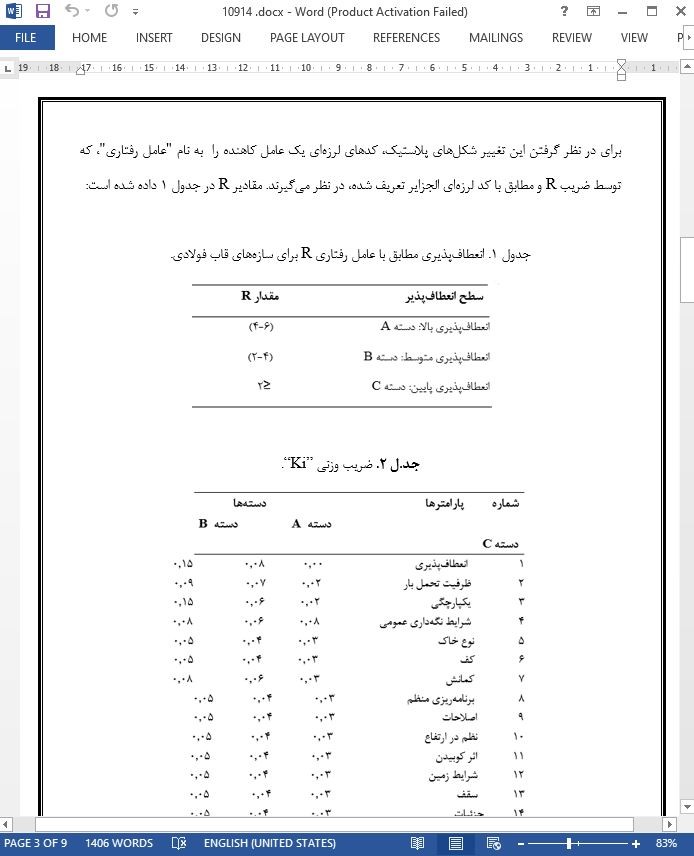
محاسبه شاخص آسیب پذیری لرزه ای سازه های فولادی
چکیده
آنالیز آسیب پذیری لرزه ای سازه های فولادی نیاز به اطلاعات پایه در مورد خواص فیزیکی و مکانیکی این سازه ها دارد. هدف مطالعه حاضر کمی سازی آسیب پذیری لرزه ای سازه های فولادی از طریق استفاده از اطلاعات مورد نیاز، می باشد. اولین گام برای انجام این کار، شناسایی پارامترهای اصلی است که نقش مهمی در آسیب پذیری لرزه ای چنین سازه هایی ایفا می کند. سپس با استفاده از بازخورد تجربی لرزه ای، ضرایب وزنی هر پارامتر تعیین می شود. یک عبارت از شاخص آسیب پذیری داده شده و بر اساس مقدار به دست آمده، یک ساختمان مورد مطالعه طبق طبقه بندی پیشنهادی به عنوان مکان امن یا ناامن طبقه بندی می شود. یک برنامه شاخص آسیب پذیری (VIP) به منظور طبقه بندی سازه های فولادی توسعه داده شده است. این برنامه برای مطالعه چندین نمونه استفاده می شود. نتایج در مقایسه با مشاهدات موقعیتی رضایت بخش است.
1. مقدمه
این سازه ها به علت سبکی و انعطاف پذیری شان مزیتی در مقابل تنش لرز ه ای دارند. علیرغم داشتن چنین ویژگی ها و مشخصه هایی، سازه های فولادی پس از یک زمین لرزه آسیب جدی می بینند. ارزیابی آسیب پذیری لرزه ای سازه های فولادی موضوع چندین مطالعه از جمله: HAZUS، RISKE-UE و RADIUS بوده است. جایی که منحنی های آسیب پذیری با استفاده از شاخص آسیب پذیری ایجاد شده اند. این شاخص براساس پارامترهای مؤثر بر رفتار لرزه ای سازه های فولادی محاسبه شده و توصیف کیفیت لرزه ای چنین سازه هایی را امکان پذیر می سازد.
5. نتیجه گیری
در این مطالعه یک روش شاخص آسیب پذیری برای سازه فولادی تهیه و ارائه شده است. این شاخص به طور خاص برای سازه های فولادی تدوین شده، که نتایج معقول و منطقی با توجه به تأثیر پارامترهای مختلف مانند انعطاف پذیری، ظرفیت تحمل بار و کمانش؛ بر رفتار لرزه ای سازه های فولادی ارائه می کند. یک طبقه بندی ایجاده شده است؛ نتایج حاصل از این طبقه بندی مطابق با نمونه انجام شده در محل می باشد. در نتیجه، این طبقه بندی می تواند توسط مهندسان برای کاهش خطر لرزه ای و تلفات در صورت وقوع زلزله مورد استفاده قرار گیرد.
Abstract
Seismic vulnerability analysis of steel structures requires some basic information on their mechanical and structural properties. The present study aims to quantify the seismic vulnerability of steel structures, through the use of the needed information. The first step to do so is the identification of the main parameters that play an important role in the seismic vulnerability of such structures. Then using seismic feedback experience, weighting coefficients of each parameter are determined. An expression of a vulnerability index is given and based on the obtained value a building under study is classified as safe or unsafe according a proposed classification. A vulnerability index program (VIP) is developed in order to classify steel structures. This program is used to study several examples. The results are satisfactory comparing with in situ observations.
1. Introduction
Steel structures offer an advantage against the seismic stress due their lightness and ductility. Despite these characteristics steel structures can suffer significant damage after an earthquake [1,2]. The assessment of the seismic vulnerability of steel structures has been the subject of several studies HAZUS, RISK-UE, and RADIUS. Where vulnerability curves have been established using vulnerability index [3,4,5].This index is calculated based of some parameters having an influence on the seismic behaviour of steel constructions and allowing description of seismic quality of such constructions [6].
5. Conclusions
A vulnerability index method for steel structure has been developed and presented in this study. Elaborated specially for steel structures, it gives reasonable results regarding the influence of the different parameters such as Ductility, Bearing capacity and Buckling, on the seismic behaviour of steel structure. A classification has been established; the results from this classification are in accordance with the one done in situ. As a result, this classification can be used by engineers to reduce seismic risk and casualties in case of an earthquake.

چکیده
1. مقدمه
2. روش شاخص آسیب پذیری
1.2. پارامترهای انتخاب شده
2.2. کمی سازی پارامترها
3. نمودار تدوین شده
4. کاربرد
1.4. مطالعه موردی یک
2.4. مطالعه موردی دوم
5. نتیجه گیری
Abstract
1. Introduction
2. Vulnerability index method
2.1. Selected parameters
2.2. Parameters quantification
3. Elaborated chart
4. Application
4.1. Case study one
4.2. Case study two
5. Conclusions
- اصل مقاله انگلیسی با فرمت ورد (word) با قابلیت ویرایش
- ترجمه فارسی مقاله با فرمت ورد (word) با قابلیت ویرایش، بدون آرم سایت ای ترجمه
- ترجمه فارسی مقاله با فرمت pdf، بدون آرم سایت ای ترجمه
